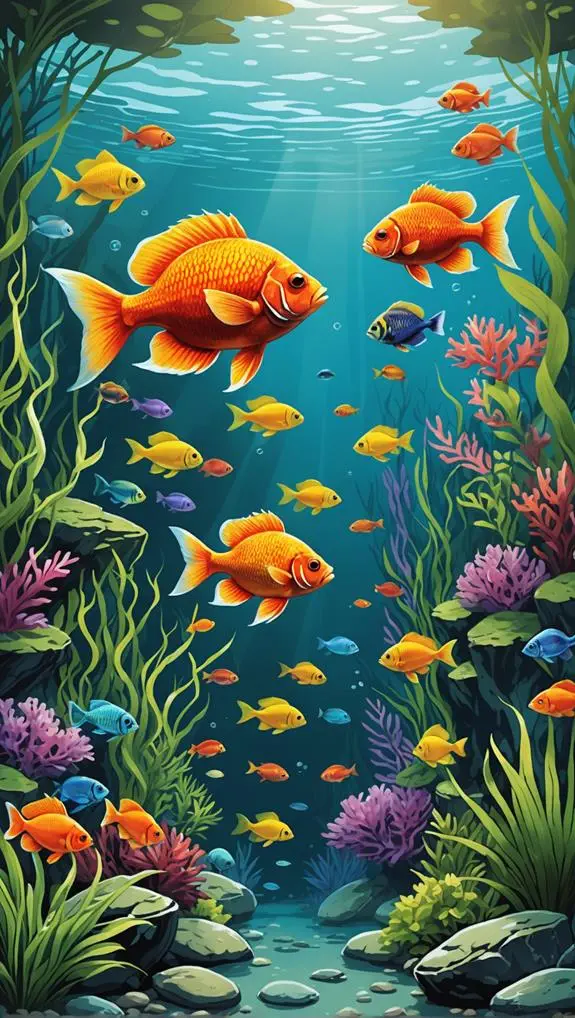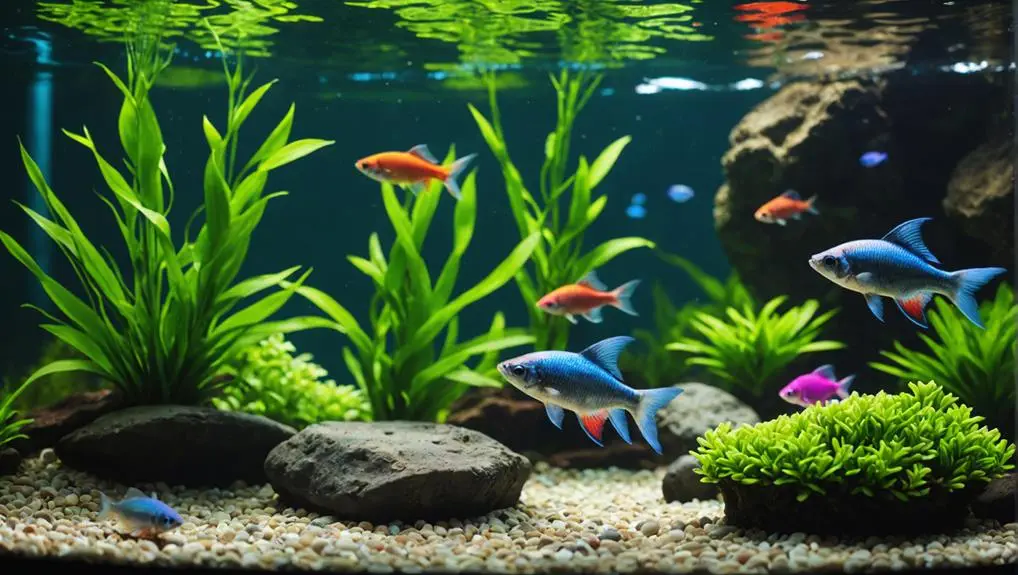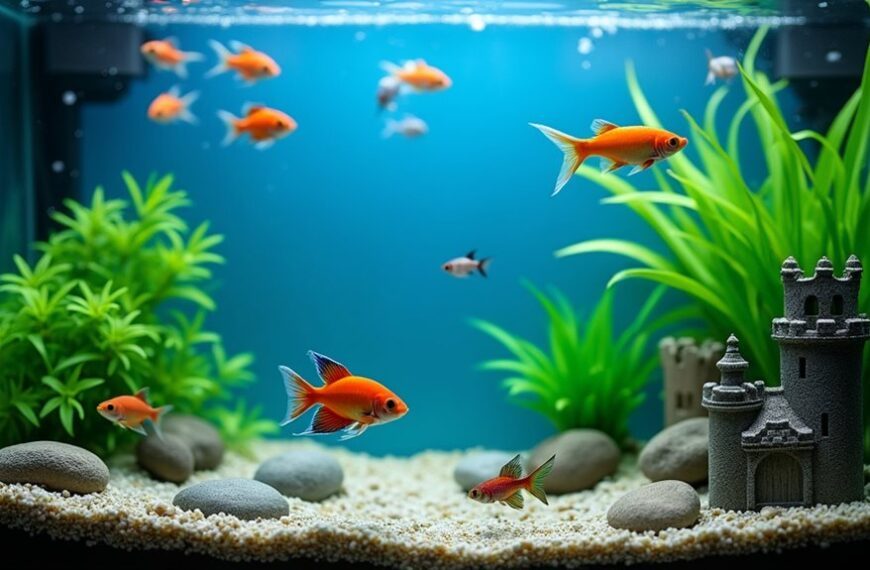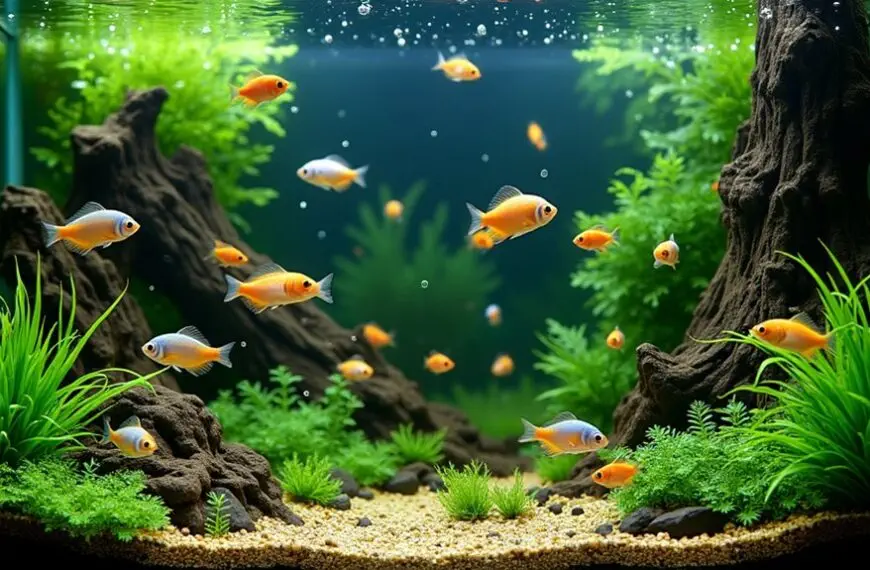Choosing fish for your new aquarium is crucial for a thriving aquatic world. For small tanks (5-10 gallons), consider Neon Tetras, Guppies, or Platies; they're colorful and easy to care for! In medium tanks (20-50 gallons), Gouramis and Barbs can add fun. Large tanks (125+ gallons) can house lively Oscars or Cichlids, but make sure to maintain peace by choosing compatible species. Always keep schooling fish in groups of six or more for a harmonious vibe. Lastly, don't forget about water quality—your finned friends will thank you! Stick around, and you'll uncover more about keeping your tank healthy and vibrant.
Contents
- 1 Ideal Tank Sizes for Beginners
- 2 Top Fish for Small Tanks
- 3 Recommended Fish for Medium Tanks
- 4 Best Choices for Large Aquariums
- 5 Important Stocking Guidelines
- 6 Compatibility of Freshwater Fish
- 7 Feeding and Care Essentials
- 8 Common Mistakes to Avoid
- 9 Where to Buy Healthy Fish
- 10 Resources for New Fishkeepers
- 11 Frequently Asked Questions
- 12 Final Thoughts
Ideal Tank Sizes for Beginners
When starting your aquarium journey, what size tank should you choose? For new aquarium owners, a 5-10 gallon tank is often ideal. It's perfect for small hardy fish like tetras or guppies, who are great companions in a community aquarium.
Fish in this size range usually grow to about ½ to 2 inches, allowing you to maximize your stocking capacity without overcrowding. It's essential to select the right fish species that are compatible with each other to ensure a peaceful tank environment.
Of course, you'll need to keep an eye on water quality. Regular monitoring is crucial, especially in smaller tanks, because they can experience rapid changes that stress your fish.
If you're feeling adventurous and want more fish variety, consider a 20-50 gallon tank. This size opens the door to moderately sized fish, like gouramis or barbs, that thrive in stable conditions.
While larger tanks, like those over 125 gallons, can be tempting for their potential, they require careful management.
Top Fish for Small Tanks
When you're setting up a small tank, picking the right fish is key to creating a happy underwater world. Consider fish that are easy to care for and thrive in community settings, such as colorful Tetras or lively guppies—they not only fit well in 5-10 gallon tanks but also love to hang out in groups, adding life to your little slice of nature.
It's essential to ensure their compatibility with tank mates, as well as their schooling needs, so everyone gets along and has a great time swimming around! For maintaining optimal conditions in your tank, remember to monitor water quality regularly.
Ideal Small Fish Species
In small aquariums, choosing the right fish species can make all the difference in creating a vibrant and harmonious environment.
You'll want to consider small fish species that thrive well together. Neon tetras are a fantastic choice! These little guys grow to about 1-1.5 inches and love to school, so grab at least six to brighten up your tank.
Another colorful option is harlequin rasboras. They reach around 2 inches and are known for their peaceful nature, making them perfect for a community tank.
Platies are also great; they grow up to 3 inches and adapt easily to different water conditions. Plus, they bring a splash of color to your setup!
Don't forget about corydoras catfish! These friendly bottom dwellers help keep your tank clean and should be kept in groups of three to six for optimal interaction.
Lastly, guppies are hardy little fish that can handle various foods, making them ideal for beginners like you.
Tank Size Recommendations
Choosing the right tank size is crucial for the health and happiness of your fish. If you're starting with a 5-10 gallon tank, you'll find several fish species that are perfect for you.
Small schooling species like Tetras—think Serpae and Black Phantom—love to hang out in groups of 4-6. It's like a little fishy party in your tank!
For beginner aquarists, livebearers such as guppies and platies are also great options. Just remember to keep a ratio of 1 male to 2-3 females to keep the peace.
And don't forget about Corydoras catfish! These little bottom dwellers thrive in groups of 4-6 and help keep your tank clean while adding some charm.
When selecting fish, aim for those that max out at about 2 inches in size. This helps avoid overcrowding and keeps everyone swimming happily.
If you later decide to upgrade to larger tanks (20-50 gallons), you can explore more varieties like Gouramis and Barbs, which are a bit bigger. Your fish will appreciate the extra space, and you'll love watching them thrive!
Compatibility and Schooling Needs
Understanding your fish's compatibility and schooling needs is key to creating a thriving aquarium. In a small tank, choosing the right schooling fish can make all the difference.
For instance, Neon Tetras are vibrant and need to be kept in groups of six or more to truly shine and show their natural behavior. Likewise, Cherry Barbs thrive in similar numbers. They might be semi-aggressive, but when kept in groups of at least six, they often chill out and become more sociable.
Don't forget about Corydoras! These bottom-dwellers love company and do best in groups of three to six. They're social little guys that will appreciate the extra friends.
When you mix species, consider compatibility; Guppies and Platies can coexist well with these schooling fish, but keep an eye on any signs of aggression.
Recommended Fish for Medium Tanks

When you're setting up a medium tank, choosing the right fish is key to creating a lively community.
You'll want to pick species that get along well and fit comfortably in your space—like Gouramis and Barbs, which love to socialize.
It's important to consider species temperament to ensure harmony in your aquarium.
Ideal Species Selection
Setting up a medium aquarium (20-50 gallons) opens up a world of vibrant fish options that can create a lively and visually stunning environment. Choosing the right species is key for your aquarium's success.
Here are some ideal species selections for beginner fish that thrive together:
- Gouramis: Pearl Gouramis are perfect! They enjoy slightly warmer water and do best in groups.
- Tetras: Neon or Cardinal Tetras are fantastic community fish. Their peaceful nature and vibrant colors will light up your tank. Just remember to keep at least six for comfort!
- Barbs: Cherry and Tiger Barbs are active and hardy, adding visual interest. They also thrive when kept in schools of six or more, which helps minimize aggression.
- Corydoras Catfish: Bronze or Albino varieties make great bottom dwellers. They help keep your substrate clean and prefer to hang out in groups of six.
With these options, you'll create a harmonious environment that serves your fish well.
Remember to monitor your water parameters to keep everyone happy. Happy fish-keeping!
Tank Compatibility Considerations
To create a thriving community tank in your medium aquarium, it's crucial to consider tank compatibility among the fish species you choose. You'll want to select peaceful small fish that get along well together. Gouramis, like Three Spot and Pearl, and Barbs, such as Tiger and Cherry, are fantastic options. They adapt easily and love to swim around, making your tank lively.
When adding live-bearing fish like Platies, remember to maintain a ratio of one male to two or three females. This balance helps minimize aggression and keeps everyone happy.
For the bottom of your tank, Corydoras are perfect! They not only promote substrate cleanliness but also fit in well with mid-water schooling fish.
However, steer clear of aggressive fish like cichlids or Goldfish. Goldfish need more space and can create quite the mess, making them poor neighbors for your community tank.
Always research compatibility before introducing new fish to avoid stress and territorial disputes.
With careful planning, you'll create a harmonious environment where all your fish can thrive and bring joy to your aquarium!
Best Choices for Large Aquariums
Creating a thriving aquatic community in a large aquarium opens up exciting possibilities for new owners. With 125 gallons or more at your disposal, you can choose from a variety of larger species and community fish that will make your tank a vibrant ecosystem.
Here are some great choices:
- Oscars – These engaging fish can grow up to 14 inches and bring personality to your tank.
- Rainbowfish or Rummy Nose Tetras – These peaceful schooling fish add color and help reduce stress for your larger species.
- Cichlids – Consider Angelfish or Bolivian Rams for their social interactions; they thrive in larger aquariums.
- Catfish – Giraffe Catfish and plecos are fantastic for algae control and enhance fish health.
When choosing your fish, remember to maintain appropriate water parameters and enrich the environment with plants and hiding spots.
It keeps your fish happy and healthy! By thoughtfully selecting your aquatic residents, you'll create a lively community where everyone thrives.
Important Stocking Guidelines

Selecting the right fish is just the beginning; understanding how to stock your aquarium properly is vital for a thriving aquatic environment.
To start, it's best to introduce only 2-3 fish at a time. This allows the nitrogen cycle to establish without overwhelming your tank. Remember the golden rule: one inch of adult fish per gallon of water. This guideline helps prevent overcrowding, ensuring your fish have room to swim and the water stays clean.
When you're choosing fish, prioritize non-aggressive species. This helps minimize stress and keeps the peace in your underwater community. It's crucial to research the adult sizes of different species, as juvenile sizes can be misleading. You want to avoid stocking capacities that lead to chaos instead of harmony!
If you're considering schooling fish, gradually introduce them in groups of six or more. This promotes better social behavior and stability in your aquarium. Fish need friends, after all!
Compatibility of Freshwater Fish
When it comes to keeping your freshwater fish happy and healthy, choosing compatible species is key.
You'll want to watch out for any potential aggression levels, especially if you've got feisty fish like cichlids in the mix, or you might find yourself playing referee!
And don't forget about schooling fish—these little buddies thrive in groups, so grab at least six of them to keep the good vibes flowing in your aquarium.
Choosing Compatible Species
Choosing compatible fish species is essential for a harmonious aquarium environment. When you're setting up your tank, it's not just about picking your favorites; it's about creating a space where everyone can thrive together.
To help you out, here are some key points to consider:
- Mix Species Wisely: Combine bottom dwellers like Corydoras with mid-level swimmers like tetras. This keeps your fish from bumping into each other all the time.
- Mind the Size: Keep smaller fish away from larger, predatory species. Your little ones deserve to swim safely without turning into dinner!
- Schooling Fish: Fish that come in schools, like tetras and rasboras, should be in groups of six or more. They feel more secure and less stressed when they're with their buddies.
- Gender Dynamics: Be careful with male-to-female ratios. Too many males can lead to territorial disputes, especially in species known for their feisty behavior.
Monitoring Aggression Levels
Monitoring aggression levels in your aquarium is crucial for maintaining a peaceful environment. You want your fish to thrive, not just survive, right? Before fully introducing new fish, observe their interactions. Some species, like cichlids, can be a bit feisty, especially during breeding season.
Look for signs of stress in your tank mates; if you notice hiding, refusal to eat, or fin nips, it's time to step in.
Creating a balanced community atmosphere helps too. Consider adding visual barriers—decorations that provide hiding spots can give less dominant fish a safe place to retreat. When introducing schooling fish, aim for at least six in a group. This can help reduce aggression, making them feel more secure and less isolated.
Lastly, keep in mind the temperaments of your fish. Mixing peaceful fish, like rasboras, with more aggressive species can lead to territorial disputes and anxiety for everyone involved.
Schooling Fish Dynamics
Creating a harmonious aquarium relies not just on monitoring aggression levels, but also on understanding the dynamics of schooling fish. These lively inhabitants can truly enhance your tank's aquatic visual appeal.
Here are some key points to consider when thinking about schooling fish and their compatibility with tankmates:
- Group Size Matters: Schooling fish like tetras and rasboras thrive in groups of at least six. This helps reduce stress and keeps aggression at bay.
- Semi-Aggressive Species: Fish like barbs should also be in groups of six or more to promote their natural behavior and minimize their semi-aggressive tendencies.
- Peaceful Pairings: Mixing peaceful schooling fish, like neon tetras, with non-aggressive species can create a harmonious community. Just be cautious of more territorial fish, such as cichlids.
- Balance is Key: Optimal group dynamics require balancing species sizes and temperaments. This helps to reduce predation risk, especially when introducing new fish.
Feeding and Care Essentials

When it comes to feeding your aquarium fish, understanding their specific dietary needs is crucial for their health and happiness. Each fish species has unique nutritional requirements, so it's essential to tailor their meals accordingly. For instance, bottom feeders like Corydoras thrive on sinking tablets or wafers, while herbivores like Uaru appreciate herbivore pellets.
Implementing a consistent feeding schedule helps keep things organized, but don't forget about portion control! Overfeeding can lead to water quality issues, stressing your fish and creating an unhealthy environment. Regularly check your water quality parameters—ammonia, nitrite, and nitrate levels—to ensure everything stays stable and vibrant.
Mix up their diet with different types of food, like flakes, pellets, and even frozen treats. This variety not only meets their dietary needs but also promotes healthy growth.
Remember, happy fish make for a lively aquarium! So take the time to research the specific care requirements for your fish species. By doing so, you'll create a thriving underwater world that looks great and brings you joy.
After all, a well-fed fish is a happy fish!
Common Mistakes to Avoid
Many new aquarium owners make critical mistakes that can jeopardize their fish's health and the overall stability of their tank. By avoiding some common pitfalls, you can create a thriving environment for your aquatic friends.
Here are four mistakes to steer clear of:
1. Overstocking tanks: Adding too many fish at once can lead to poor water quality and stressed fish.
Introduce only 2-3 fish at a time and be patient while the nitrogen cycle establishes.
2. Ignoring fish compatibility: Mixing aggressive species like cichlids with peaceful fish can cause chaos.
Research your fish's temperaments to keep everyone safe and happy!
3. Neglecting dietary needs: Different fish have unique diets.
Bottom feeders like Corydoras need sinking pellets, not leftover floating food that others might ignore.
4. Skipping water quality monitoring: Regularly check your tank's parameters.
Failing to do so can lead to ammonia spikes that harm your fish, leaving you with a sad aquarium.
Where to Buy Healthy Fish

Finding a reliable source for healthy fish is crucial for any new aquarium owner. You want your aquatic friends to thrive, so start by visiting reputable local tropical fish stores or aquarium specialty shops. These places usually prioritize fish health and care, ensuring you get the best options for your tank.
Before you make a purchase, inquire about the fish's adult size and specific care requirements. You don't want to end up with a giant fish in a tiny tank!
While you're there, take a moment to observe fish behavior. Look for active swimming and feeding habits; that's a good sign they're healthy and ready to join your home.
Don't forget to check for visible signs of disease, like cloudy eyes, wounds, or fin rot. If you spot any of these issues, it's best to walk away.
Also, consider joining online fishkeeping communities for recommendations on trusted retailers. Fellow fish enthusiasts can point you in the right direction and help you avoid any fishy situations!
With the right source, you'll be well on your way to creating a vibrant aquarium filled with happy, healthy fish.
Resources for New Fishkeepers
After securing a reliable source for healthy fish, you'll want to explore various resources that can support you as a new fishkeeper.
These tools will help you navigate your fishkeeping journey, making it more enjoyable and fulfilling.
Here are some fantastic resources to consider:
- Local tropical fish stores – They offer invaluable advice on fish species compatibility, care requirements, and feeding practices. Plus, you can chat with knowledgeable staff who love fish just as much as you do!
- Comprehensive care guides – Check out aquarium websites that provide detailed information on the specific needs of different fish species, including ideal water parameters and dietary requirements.
- YouTube channels – Dive into instructional videos that cover tank setups, fish care, and more. They're perfect for those who learn best by watching.
- Social media platforms – Join groups or pages dedicated to aquarium care. Here, you can engage with experts and fellow beginner fishkeepers, sharing experiences and getting real-time advice.
With these resources, you'll be well-equipped to create a thriving underwater world!
Happy fishkeeping!
Frequently Asked Questions
What Is the Best Starter Fish for a New Aquarium?
When choosing the best starter fish, consider colorful options like guppies and platies. They're small tank fish and beginner-friendly species that thrive in community settings, offering easy care and compatibility for your aquarium.
What Is the First Fish to Put in a New Aquarium?
When starting your new aquarium, consider beginner fish species like Zebra Danios. Focus on the tank cycling process, follow fish acclimation tips, and prioritize water quality to ensure compatible fish selection for a thriving community.
What Is the Best Fish to Add to a New Tank?
Choosing the right fish is like selecting companions for a journey. You'll want beginner-friendly options, considering tank size and water quality. Prioritize fish compatibility and first week care to avoid common mistakes that can derail your efforts.
What to Get for a First Time Fish Owner?
As a first-time fish owner, focus on avoiding common mistakes like improper tank cycling and neglecting water parameters. Choose compatible species, consider tank size, and follow feeding guidelines for successful aquarium maintenance. You'll thrive with care!
Final Thoughts
So, you're ready to dive into the fishkeeping world—like a modern-day Aquaman! Remember, choosing the right fish and setting up their home is just the start. Keep an eye on their needs, avoid common rookie mistakes, and soon enough, you'll have a lively underwater paradise. With the right care, your tank can flourish like a coral reef. Enjoy the journey, and don't hesitate to ask questions along the way. Happy fishkeeping!












